A map of the surface of Mars, showing where some volcanoes are located.
Click on image for full size
Image from: NASA
Martian Volcanoes
On this map of Mars, the lightly cratered Tharsis Ridge is shown, as well as the heavily cratered Martian highlands (near the bottom of the picture), and Valles Marineris to the right. The volcanoes are the yellow and red dots in the sea of blue in this image.
The Tharsis Ridge is the home of several volcanoes, including Olympus Mons. Olympus Mons is the leftmost volcano in the image. The three large volcanoes which accompany Olympus Mons on the Tharsis Ridge are Arsia Mons, Pavonis Mons, and Ascraeus Mons. Measurements returned by Mars Global surveyor demonstrate the very large size of these volcanoes. Other volcanos named Tharsis Tholus, Ceraunius Tholus, Elysium Mons, and Albov Tholus are found in the right-hand side of the large topographic
map of Mars, as well as the very large version of the map to the left.
These volcanoes came into being early in Martian history.
You might also be interested in:
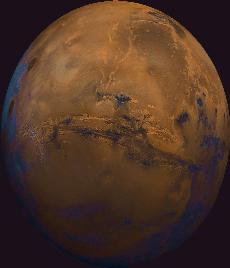
Next to the Tharsis Ridge is Valles Marineris. Valles Marineris is a large system of canyons that stretches 4000 km (2500 mi) along the equator of Mars. It was first imaged in detail by Mariner 9. As can
...more
The largest volcano in the solar system is Olympus Mons, shown in the image to the left. Olympus Mons is a Martian shield volcano. The altitude of Olympus Mons is three times the altitude of the largest
...more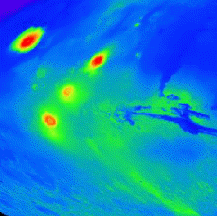
On this map of Mars, the lightly cratered Tharsis Ridge is shown, as well as the heavily cratered Martian highlands (near the bottom of the picture), and Valles Marineris to the right. The volcanoes are
...more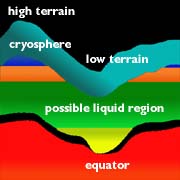
On Mars, the water is trapped, frozen, within the ground. Nevertheless, there is evidence for running water on Mars. When the water is melted and released to the surface, it will run from higher ground
...more
The drawing shows a crossection of the crust, and the unusual altitude variation of the Martian surface. The figure illustrates the depth of frozen ground at various latitudes, called the cryosphere. The
...more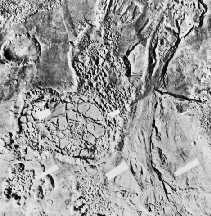
Separate from the Martian outflow channels, or the river valley networks, are large Martian lakes (600 km, or ~1000 miles across) which exhibit evidence of a periodic and catastrophic release of water
...more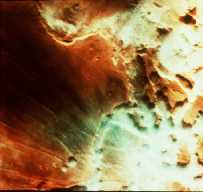
This is an image of fog in a Martian canyon. The presence of fog provides evidence of water, and a water cycle on Mars. More fog has been seen in images returned by Mars Global Surveyor of the south polar
...more
The Martian climate is more influenced by the shape of the Martian orbit than the climate of the Earth is influenced by the shape of the Earth's orbit. The orbit of Mars is more oval-shaped than that
...more













